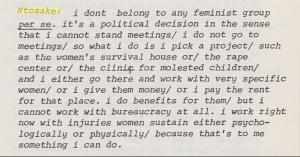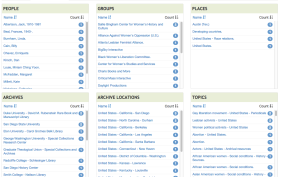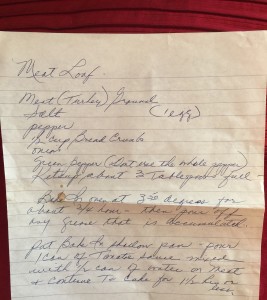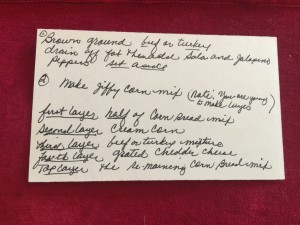I learned in a photography class at Barnard that early photography began to flourish among the masses with the adoption of portraiture by the middle class in the mid-1800s. Disderí, the European photographer who became famous for photographing the masses, created small photos of people called carte de visite that were more accessible to the middle class. He was often contrasted with other photographers who only photographed the rich. The professor argued that the middle class used photography as a statement of their status and as a way of self-fashioning. We, the students in the class, were prompted to inquire as to what the subjects of photographs were trying to say. Most of the photographs we looked at in this class were not created by black Americans nor did they feature people of color.
Third World Women’s Alliance/Making Use of Digital Archives
First edition of Triple Jeopardy, the newspaper of the Third World Women’s Alliance
I wanted to just make a pitch to everyone to remember that you can find primary sources in rooms beyond those designated as “archives” cultural institutions like the Schomburg: sometimes they are in main collections or (since digitization is happening at an increasing rapid clip) online. You should be inventive and wide-ranging when looking for accessible copies of works you might want to use. For example, following up on Michelle’s Archive Task #1, I was trying to see if there was anyplace in NYC that has papers related to the Third World Women’s Alliance. The main branch of the NYPL (not the “archive” per se) has Triple Jeopardy, the newspaper of the TWWA, in its main collection. However, that journal is also available online in the Independent Voices database.
Independent Voices is an open-access collection of digitized independent publications. It can be a very rich source for Black Power/”post” Black Power and Feminist materials. For example, I found several pieces by Ntozake (also spelled Ntosake) in the database. Since some of you are interested in healing, I have a screenshot of her talking about her work with “injured” women in an extensive interview published in the literary journal, River Styx.

Ntozake’s response to interview questions from Students at Harris-Stowe College in Saint Louis (1978). Note the use of the dash in the interview transcription.
I highly recommend this interview, Shange talks about many of the things you are investigating now: Black Power, Spirituality, Third Worldism, Feminism, childhood, etc. Independent Voices also suggests that you help with digitization by correcting some of the OCR (Optical-Scanning Recognition) errors.
Closer to home, I discovered that the Columbia literary magazine, Emanon, published some of Ntozake Shange’s poetry from when she was a Barnard Student (search Paulette Williams).
The Holiness of a Cookbook
While reading both Shange and Mae’s cookbooks I took time to think about the ways in which cooking is important in my family. The first thing that came to mind is the cookbook that my mother keeps which contains recipes from my grandmother and great grandmother and some of our current favorite dishes. To be honest, my mother really does not do too much cooking, my grandmother was the cook in our household until she passed away. My grandmother is no longer here to cook for us, so having a catalogue of her recipes is like preserving the memory of her existence in our household. Her recipes are proof that she did not leave us empty, but left behind ways of nourishing our bodies. This way my grandmother can continue to fill our stomachs despite her not physically being here. Now my mother’s cookbook, our cookbook, is not the same book my Nana (great-grandmother) used. My mother has updated the book itself, but the recipes on cards and sometimes scraps of paper are still the same. Shange writes that “[c]ooking is a way of insisting on living,” I also think that recipes themselves are a way our elders insist on continuing to live with us after their passing (If I Can Cook/ You Know God Can, Ntzoake Shange, 70). This is how we refuse the idea that black culture is static and was ruptured during the Middle Passage. The fact that black people can pass down recipes and see the similarities in traditional dishes among different peoples of color prove that “[w]e are not folklore,” (Shange, 32).
It resonated with me when I read that Mae does not cook with measurements and relies on the feel of things. Reading this reminded me of what I’ve seen in my own home.
And when I cook, I never measure or weigh anything. I cook by vibration. I van tell by the look and smell of it. Most of the ingredients in this book are aproximate. Some of the recipes that people gave me list the amounts, but for my part, I just do it by vibration. Different strokes for different folks. Do your thing your way.
(Vibration Cooking, Verta Mae, xxiii)
In my family’s cooking all of the recipes from my Nana and many of those from my grandmother are without certified measurements. Many describe using a tea cup as a measure. Now, what size tea cup, I have no idea. I believe that is what Mae describes as “[d]different strokes for different folks” cooking,” (Mae, xiii). Deciding to not use measurements also makes cooking a learning experience instead of following someone else’s formula. I believe that this is how the act of cooking becomes nourishment in itself, that making your own food is akin to the magical-like home remedies in Sassafrass, Cypress & Indigo. Not only is the food nourishing, but the process of cooking and creating on your own terms is liberating.
Below are some photos of recipes from my family’s cookbook:
(My great grandmother’s recipe with measurements adapted by my mother)
(My grandmother’s recipe)
(My Aunt Gwen’s Recipe)
Revelations on Carnal Intellectuality
Shange’s visit gave me to the opportunity to ask her questions and connect the dots between ideas I have been developing throughout the semester. I was able to address issues I have been struggling with in my previous blog posts. These issues included questions Professor Hall and Tiana had in response to my blog post “Dance: as a means of survival and a revelation of truth” which was a response to Clarke’s blog post “Sweat, Truth and Survival.” They asked,
“What kinds of truth does the body contain that aren’t as accessible in other ways?”
&
“What does truth mean (in my, Clarke or Shange’s writing)?”
I wrote my previous blog post in an attempt to understand why and how dance is so central to Shange’s work as a writer. I started to gain a greater understanding of Shange’s idea of truth when I asked her what the relationship was between dancing and cooking. I noted that she writes about cooking in From Okra To Greens as a mode for survival and self-preservation in a similar way to which she writes about dance in her other works.
I particularly observed this in the way in which she talks about cooking in “From Okra to Greens / A Different Love Poem / We Need a Change.” In this poem she writes:
i lived in her kitchen/ wit greens i cd recollect
yes the very root of myself
In response to my question, Shange said that cooking and dance are connected to her because both allow her to participate in a tradition of people of color that has existed for centuries and therefore, allows her to feel connected to people of color throughout time and throughout the world.
I began to understand the centrality of dance as I marveled at how dance, for Shange, cannot be separated from anything else in her life. Even in her discussion about cooking she mentioned that she dances in the kitchen while cooking. For Shange, the completion of a thought cannot be expressed in words, but rather is completed with a gesture. While writing, she dances in her seat to the tapping of the keys or to the rhythm of the music she is listening to. Shange’s response reminded me of her concept of carnal intellectuality which is a way of knowing that can only be processed, understood, and expressed through the body. Therefore, truth for Shange may have less to do with what is said, but rather what is felt and experienced.
Dance: A means of survival and a revelation of truth
I really like Clarke’s question in her blog post “Sweat, Truth and Survival:“In what ways does Shange characterize truth and survival as “one”?” There are probably several lenses through which one could tackle this question and here I will attempt to offer one.
In the readings we have done thus far, dance is key for liberation of the black woman and Shange’s choreopoem “for colored girls who have considered suicide when the rainbow is enuf” continues to express this idea.
In the first poem “dark phases,” Shange shows the importance of giving women a voice and the opportunity to be heard. Not only does Shange give voice to the “dark phases of womanhood/ of never having been a girl” (17), but she also encourages the audience to be intimate with the woman’s story, to “sing her rhythms/ carin/ struggle/ hard times. sing her song of life” (18). As the audience becomes familiar with the woman’s song, so does the woman herself who has “been dead so long/ closed in silence so long/ she doesn’t know the sound of her own voice/ her infinite beauty” (18). As for colored girls progresses, one discovers that the woman’s voice dwells in her body.
Soyica Diggs Colbert’s article “Black Feminist Collectivity in Ntozake Shange’s for colored girls…” talks about how black women’s bodies are sexualized and demonized. However, she goes on to say, “Rather than trying to assimilate into a system of desire that diminishes the shape of the black woman, Shange suggests that in order to find her voice she needed to accept her body. Dance was part of the process of moving toward acceptance.”
More than self-acceptance, dance is a means of survival.
“we gotta dance to keep from cryin/ we gotta dance to keep from dyin” (29)
“there is no me but dance/ & when i can dance like that/ there’s nothing that cd hurt me” (57)
Dance is a revelation of truth because it embodies a woman’s very essence, which is something that cannot be fully expressed in words. The lady in purple says “to come wit you/ i hadta bring everything/ the dance & the terror” (58). “[the lady in green] is Sechita and for the rest of the poem dances out Sechita’s life” (37), revealing the goddess of creativity and love through movement.
Dance also reveals truth because it makes up for the limitations of language. Dance, unlike spoken language, has the ability to live in silence, in “melody-less-ness” (17).
So, how does Shange characterize truth and survival as ”one”? She does this by showing dance is survival and dance reveals the truth. However, a question I would like to explore in future blog posts is, “What is truth for us as readers and for Shange?”






